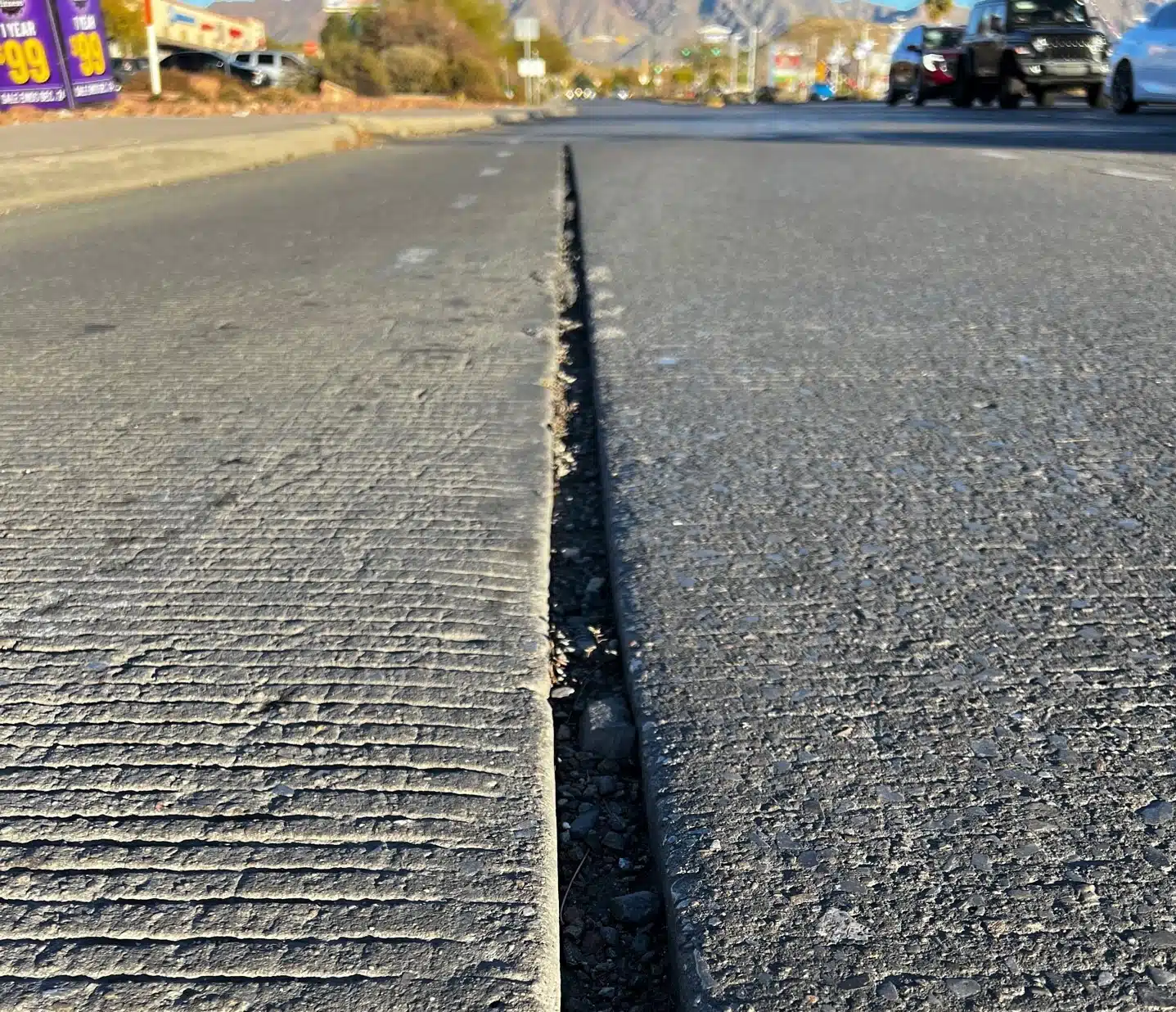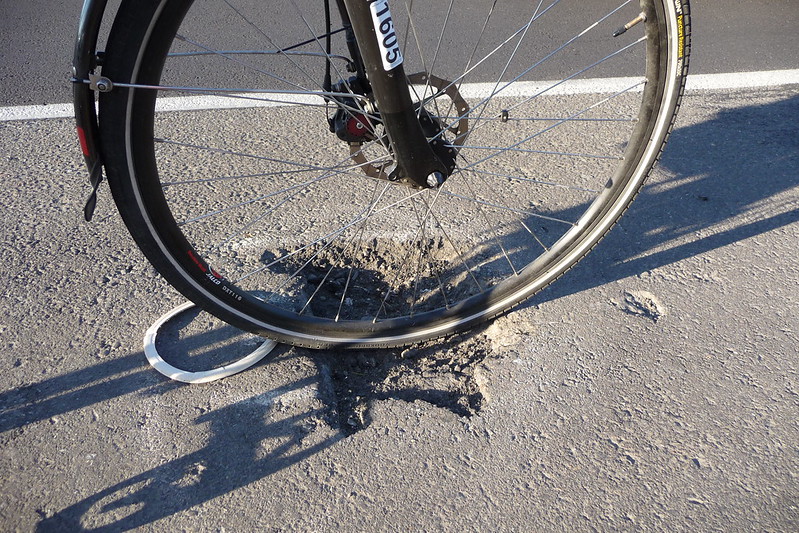For a person in a car, rolling over a shallow three-inch gap in the surface of the roadway probably won't feel like anything at all. For cyclists though, that's just the right size to grab onto a thin tire, hurtling a rider off his bike and straight onto the asphalt.
That's what happened to Mike Bagg, whose life was upended when he hit a tiny crevice between two concrete panels embedded in the surface of an El Paso bike lane maintained by the Texas Department of Transportation in 2016. The crash caused injuries so extensive that he'd need to relearn how to walk and disrupted his professional practice as a surgeon, as well as his ability to care for his special-needs son.
Seven years and $70,000 in medical bills later, Bagg is finally getting some justice — though the lawyers behind the suit warn that the $1.05 million he won will be capped at a payout of just $250,000 under Texas law. And despite how common roadway defect crashes are — and since they aren't tracked by federal databases, it's anyone's guess — many other cyclists in his situation are unlikely to get anything at all.
"Crashes involving defective roadway infrastructure happen all the time, but we don't track them, and it’s very difficult to win cases [like this]," said Charlie Thomas, an attorney from the Bike Law Network who handled Bagg's case. "There are all these super-high bars you have to clear, and we can't afford to take on cases where we just don’t think we have a chance."

Thomas explains that while it's normal for street surfaces to shift and crack over time, the sheer size of America's auto-centric transportation network means that the agencies often don't regularly inspect for deadly roadway defects before a cyclist crashes, even on bike lanes and other high-volume cycling routes. And when riders get hurt by broken asphalt and report it themselves, Thomas says many agencies barely even bother to track their complaints, never mind actually fix the problem.
"It’s just the nature of how many miles of roadway there are," Thomas adds. "They don't just want it to be open season on agencies for every minor abnormality. You can pretty much only get to a trial if they have prior notice of a defect. ... But it really stinks for the first person who who gets hurt, because they’re the guinea pig, and they usually have no recourse."
Later, Thomas and his colleagues would find other riders who said they'd been hurt at the exact same site of Bagg's crash, though only after going "full junior detective" and asking the members of the community via a local bike shop's Facebook page to self-report their injuries. Roughly two years before, the attorneys learned, one of those riders had even notified TxDOT that he'd been knocked unconscious after a similar incident on the same road — but the agency would later claim it never received the letter.
To non-bikers and engineers, this is what a minor road defect can do to bikers - so imagine what that would look like if bike lanes are ill-maintained and un-protected.#CommutersNaman #ProtectedBikeLanesNow #MakeItSaferMakati pic.twitter.com/7sTEQVsEkP
— Ira Cruz (@iracruz) March 15, 2023
Thomas says that's a common tactic among government agencies, which recognize that often, they alone have the ability to confirm or deny whether they were notified that a poorly maintained road was creating a hazard for cyclists — or even that multiple riders had already crashed. Thomas says they requested "10 to 12" different types of proof in Bagg's case, and the agency "stonewalled us every time."
"If the defect is glaring enough, sure, maybe we can prove that the DOT went out there and looked at it; maybe we’ve got a case," Thomas added. "But really, you’re looking for prior incidents. And even those are hard to prove, because there’s no catalog you can go to to say, 'here's everyone who got hurt here.' You really have to go straight to the DOT itself — and we’ve found over the years that their logging and collection of that info is awful."
And even when attorneys can persuade a jury that a DOT knew about a roadway defect, jurors still have to be convinced that the agency failed to fix it out of "gross negligence," rather than because it was understaffed, overwhelmed, or otherwise unable to act promptly.
Thomas says TxDOT's award caps are relatively stringent, but he stresses that certain county agencies in Texas are even worse, while other governments are functionally limited by their own insolvency; in his hometown of New Orleans, for instance, he estimates that there's a "20 to 30"-year wait just for the judgements again the city that are already on file.
He says lobbying to increase those caps would help; he'd also love to see advocates create an independent portal where victims of road defect crashes can publicly log their complaints to DOTs, so lawyers don't have to rely on the largesse of agencies to implicate themselves, or go hunting for evidence that hazards had previously been reported and ignored.
None of those strategies, of course, would help the thousands of bicyclists each year who are killed by drivers on dangerously designed roads without legally prosecutable defects like cracks in the pavement — because relative to dangerous design standards that prioritize driver speed over everyone else's safety, they're considered absolutely flawless.
And when there is a defect, Thomas stresses even robust, multi-year lawsuits like this one don't always get roads fixed quickly; in Bagg's case, he estimates that TxDOT waited more than 120 days simply to dispatch a road crew to the crash site after the agency filed an answer to his lawsuit, and it took them more than 600 days to actually fill the hole, which was thousands of days after the first crash that was formally brought to their attention.
Still, as they work to repair a broken system, Thomas urges cyclists to be as proactive as possible, and to send certified letters to their local DOTs every time they hit a potentially deadly bump in the road — even if they're not confident it will make a difference for them.
"Nobody knows about these laws until something happens to them," he said. "And then it’s too late."






